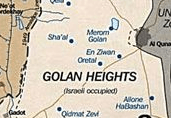“Between 30 and 40 protestors have reportedly been killed by Israeli security forces in the past three weeks. The Government of Israel has a duty to ensure that its security personnel avoid the use of excessive force.
However difficult the circumstances, the use of live ammunition against allegedly unarmed protesters, resulting in large numbers of deaths and injuries, inevitably raises the question of unnecessary and excessive use of force.”
That’s from UN High Commissioner for Human Rights Navi Pillay, who also criticized Syria over allegations that civilians were encouraged to pass through a minefield during their border protests.
This is what we know: Israeli forces opened fire on hundreds of Palestinian and Syrian demonstrators in the Golan Heights on Sunday, killing 12 people according to Israeli authorities and at least 20 according to Syrian state media. The demonstrations were in commemoration of Naksa Day in 1967, when Israel invaded Syria and took control of the Golan Heights.
Tear gas was eventually successful in dispersing the demonstrators, some of whom the Israeli Defense Forces (IDF) said were armed with Molotov cocktails and rocks, but only after live rounds had been fired. On Sunday afternoon the BBC reported that after live rounds had been fired, the official answer given to international media by an IDF spokesperson as to why tear gas had not yet been used was that firing tear gas across an international border was a violation of international law. It is not entirely clear whether this is true, but it is counter-intuitive to then assume that live fire across a border would not also be a violation of international law. The next morning, IDF spokesperson Avital Leibovitch offered a different rationale, saying that conditions such as distance and wind direction made the use of tear gas impossible and the IDF had no choice but to use live fire to defend its borders.
Adam Jones, Genocide Studies scholar and Professor of Political Science at the University of British Columbia, was in the border town of Majdal Shams just days before Palestinian and Syrian demonstrators approached the fence there. He told me the atmosphere was “completely calm.” At the Quneitra lookout, Professor Jones said, “there were both Israeli soldiers and UN troops around, and they were all relaxed and lounging about, with no sign that anything major was impending. It was surreal to see the news footage of the upheaval only a short time after.”
It is a bit surprising that a mere few weeks after unarmed, peaceful Palestinian demonstrators were killed during Nakba Day commemorations, drawing international condemnation of Israeli forces, the IDF would be so careless. Israeli authorities have insisted that the demonstrations were a provocation that required a defensive reaction, but as Professor Jones pointed out to me, “Civil disobedience actions are always provocative, if they’re successful.” Rather than using live fire on the demonstrators, Israel should have stuck with non-lethal means of crowd control. “Israel had hundreds, if not thousands, of soldiers and police on hand to deal with the situation; if any unarmed Palestinians succeeded in breaking through the fence (which none did on this occasion), they should have been arrested, detained, and expelled.”
Given the pace of events in the past few weeks, it is almost assured that future border skirmishes between protesters and Israeli authorities will occur. For the sake of both the Israelis and the protesters, let’s hope that the Navi Pillay’s message of restraint resonates.
